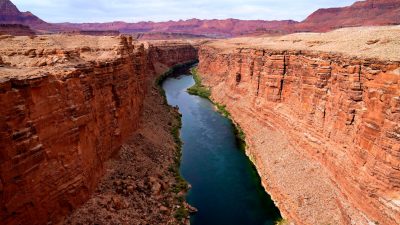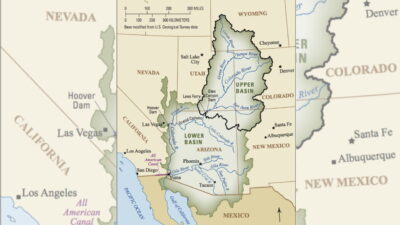
The final 100 miles of the Colorado River is a shell of its former self — nearly 10 miles wide at the turn of the century, steamboats would transport carriages and early-model cars from Mexicali to San Luis in Mexico’s Baja California state.

Jaguars, beavers, deer and coyotes roamed the fertile riparian ecosystem and farmers had more water than they knew what to do with.
Now, a weave of concrete canals brings water to sprawling industrial farms situated in the Mexicali Valley, with much of the natural riverbed dry and the wildlife sparse. Tides still drive water from the Gulf of California into the valley a few times a year, but the days of a lush river delta in northern Mexico are long gone.
So, where did all the water go? Researchers on Thursday published one of the more comprehensive analyses of the Colorado River basin attempting to answer the question.
“What we’ve never had is a complete, holistic picture of where all of the Colorado River water goes,” said Brian Richter, president of Sustainable Waters and a lead author of the study.

Richter said that includes an accounting of how all the water in Mexico is used, water that’s exported out of the basin and water from the Gila River, a major tributary of the Colorado River that flows through parts of New Mexico and Arizona.
The answer will likely come as no surprise. According to the study, published in Communications Earth & Environment, irrigated agriculture is responsible for 52% of overall consumption in the basin, and 74% of direct human consumption.
Of that 52%, crops grown to feed cattle, like alfalfa, account for 32% of all water consumed from the Colorado River.
In the upper basin, which consists of Colorado, Wyoming, Utah and New Mexico, the study found crops grown to feed cattle use 90% of all water diverted toward irrigation — that’s three times the amount of water used for municipal, commercial or industrial use combined.
Richter’s team of researchers calculated the water budget for specific crops by using satellite imagery of agricultural land, then factoring in things like climate and length of growing season to determine consumption.
“If somebody is going to make a statement about how much of the Colorado River goes to irrigated farms, we wanted to make sure they have the right statistics,” Richter said.
The remaining 48% is broken down into three categories in the study — about 18% goes to municipal, commercial or industrial uses, while 11% is lost to evaporation in reservoirs.
Evapotranspiration accounts for the last 19%, which Richter essentially defines as water for the river ecosystem, consumed by riparian and wetland vegetation. It’s a novel approach to a study of this nature, Richter said.
“Usually when people do a water budget for a river system, they’re only paying attention to the human uses. We wanted to change that conversation,” he said.
Consider these other key findings from the study:
In Mexico, 80% of Colorado River water is used for agriculture, while just 7% is left for the river’s ecosystem and 13% for municipal, industrial or commercial use. The river was overconsumed, meaning more water was taken from the river than was supplied during spring runoff, in 16 of 21 years from 2000 to 2020. Users are overconsuming about 20% of the river’s water, the study found.

The lower basin uses more water for agriculture than the upper basin — 54% of Colorado River water in the lower basin (Arizona, Nevada, California and Mexico) is used for crops and livestock, compared to 48% in the upper basin. In the upper basin, 24% of Colorado River water is consumed by the ecosystem compared to 14% in the lower basin. About 15% of the water in the upper basin is lost to evaporation in reservoirs — in the lower basin, that figure is at about 10%.
The study comes as water managers from Colorado River basin states are working on new management plans ahead of 2026, when current guidelines are set to expire. Negotiations are tense, and the states so far have yet to reach an agreement. Meanwhile, scientists estimate flows in the river have decreased by roughly 20% over the last century, with warming temperatures resulting in a 10% decrease in runoff.
Richter said he hopes the study can be of use as negotiations continue.
“We wanted to make sure those negotiators have the most accurate and the most complete estimates of where the water is going as a foundation,” he said.
By Kyle Dunphey, Utah News Dispatch
Utah News Dispatch is part of States Newsroom, a nonprofit news network supported by grants and a coalition of donors as a 501c(3) public charity. Utah News Dispatch maintains editorial independence. Contact Editor McKenzie Romero for questions: [email protected]. Follow Utah News Dispatch on Facebook and Twitter.
Copyright Utah News Dispatch, all rights reserved.